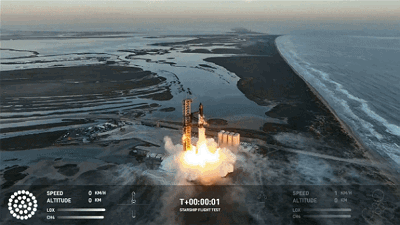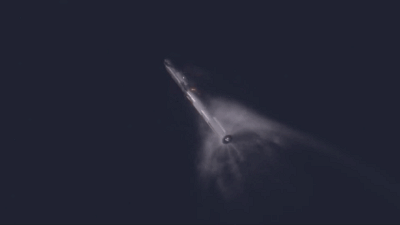Historic Day for the New Space Economy
Authored by: Jeff Brown
On Saturday morning, I stood in the middle of a small diner in downtown Utica, New York, captivated and overcome by what was happening.
The second test launch of the SpaceX Starship was on TV. This time, the goal was to get off the ground and reach space.
I can't imagine a better analog for launching my new business, Brownridge Research, and the first official issue of my — soon—daily e-letter Outer Limits if you're reading this, welcome!

I tried to explain to the owner that this was a historic day. Nothing like this had ever been done before, and it would transform the world as we know it. Despite my excitement, I didn't get a response.
Two other patrons sat at the counter, also watching the launch over breakfast. One said, "Shouldn't we be working on curing cancer instead of stuff like this?"
It's a valid question, and it's worth exploring because of issues like this.
Birth of a New Space Economy
When most people see something like this on TV, they don't know who or what is behind it. Many thought this was a government launch led by NASA.
That's one of the things that made Saturday's launch so special. It was entirely performed by a private company, SpaceX, now valued at around $150 billion. The company's founder is Elon Musk.
To put this all into context, the combined SpaceX Super Heavy Booster with the Starship on top is a massive 397 feet (an American football field is 360 feet from end zone to end zone). The Super Heavy has 33 Raptor engines capable of producing 16.5 million pounds of thrust, twice as much as NASA's Space Launch System and the Saturn V used during the Apollo program.
No one has ever accomplished anything like this before. Projects like this are the domain of large nation-states, not private companies. And yet SpaceX did it all in the private sector with private funding.
The goal of the test launch was to fire all 33 of the Raptor engines, demonstrate the hot separation of the Super Heavy with the Starship, and get the Starship to space. And that's precisely what happened. Anything else would have been a bonus.

The hot separation was stunning to watch. It's called "hot" because it burns three of the Raptor engines in the Super Heavy booster while the six Raptor engines on the Starship ignite.
Keeping the three engines ignited gives an "added boost" to the launch and increases the Starship's payload to orbit by about 10%. (Note: "Payload" is the cargo contained within the Starship being launched to space — usually that means satellites, people, supplies, or other equipment for use in space.)
This added 10% to the payload, which is enormous and symbolic of why Saturday was such a historic moment.
Space has been so inaccessible, and only the domain of large governments has been the cost of developing aerospace technology and launching payloads into space. For perspective, here is what launch costs have looked like over time:

The SpaceX Falcon 9 rocket transformed the space industry. Its launch costs per kilogram (kg) were more than 75% cheaper than the industry average over the last 20 years of more than $10,000 per kilogram.
The reason? SpaceX pushed the outer limits of aerospace engineering by making the launch booster reusable. This continued with the Falcon Heavy, which will be true of both the Super Heavy and Starship. That's why SpaceX's launch costs for payloads with the Starship will plummet again by more than 95% (compared to the Falcon 9), ending somewhere between $50-100 per kilogram.
Imagine that, for less than the cost of a nice dinner out on the town, anyone will be able to launch a kilogram (2.2 pounds) of technology — or whatever they want! — into orbit. It is unbelievable.
But we should ask, why is this so transformational? Why is this such an incredible development? The answer is simple. At $50-100/kg, an entirely new space economy will be born. At those costs, both private companies and governments can do things that weren't possible before.
For example, as early as next year, Axiom Space will launch the first module of what will become the first commercial space station in history. And again, Axiom is a private company, not a government entity.
I couldn't help but be reminded of the patron at the counter. He still needs toerstand that this new space economy isn't just about space tourism or establishing a permanent lunar base.
It also means breakthroughs in the pharmaceutical industry through space-based manufacturing, for example. And so much more.
Not coincidentally, another private company, Varda Space Industries, launched its first drug-manufacturing spacecraft on a SpaceX Falcon 9 just this June. It's the first of what will eventually be space-based manufacturing of drugs, some of which will be for cancer treatment.
There are significant benefits to manufacturing compounds in zero gravity — a topic for another day. What's most relevant is that Varda can manufacture in space economically and then return the finished product to Earth for safe retrieval.
With the SpaceX Starship launch, these developments became possible, which is one big reason why it mattered and was a historic day.
"Failure"
The Starship mission was an incredible success. Despite a communications glitch after reaching space, the Starship completed stage separation and reached a suborbital altitude — which was the intended goal.
And yet, with such an incredible development, the press wouldn't have any of it.
I tired quickly of headlines like "SpaceX Starship launch failed…"
Yet again, all the major media outlets wanted Elon Musk's head.
It reminded me of his public flogging in the early days of taking over X (formerly Twitter). Today, he continues to defend the frontline of freedom of speech and has unbanned more scientists and professionals on the platform than I can count.
He's doing this all while Google, Facebook, YouTube, and many others continue to silence scientific research that counters whatever the current narrative is — the report "they" are trying to push.
This is another reason why SpaceX's successful launch is such a good analogy for Brownridge and the launch of Outer Limits. I'm going to "go there." It's my shop. No one will censor me or modify my research before it is published.
Together, we're going to follow the data and research. Regardless of whether they fit the current narrative, we'll stay on top of the most exciting developments. We'll be exploring the outer limits of high-tech, biotech, monetary policy, fiscal policy, economic policy, and more.
We're in a world of extremes right now. Very little makes sense. And we've learned the hard way — thanks again to Elon and the release of the Twitter files — that the government and the media have been conspiring for years to control and manipulate the population and spread false narratives that are not founded in untainted, objective scientific research.
Very little is what it seems. And it is going to get worse.
But I can say with certainty that we will do our best in Outer Limits and other research I'll publish to make sense of it all. And I won't hold back.
We're in for the worst chaos we've seen in several years. For many, this might sound scary.
Yet, we also need to realize that while the world may seem to be falling apart, we'll see remarkable breakthroughs in medicine, genetic editing, aerospace, artificial intelligence, robotics, self-driving cars, nuclear fusion, augmented reality, and so much more. This means there will be incredible investment opportunities along the way.
And that's the purpose of Brownridge Research: to provide those insights, analysis, and research on incredible investment and profit opportunities for all investors.
It's wonderful to have you along for the ride. If you were a previous subscriber to my work, thank you for finding me; it's great to reconnect. Given what's coming, much more work must be done.
If you're new, welcome. It's great to have you along for the ride. Please feel free to forward Outer Limits to friends and family. As I'm starting from scratch, I can use all the help I can get.
In the future, on Fridays, I'm planning on a mailbag issue where I'll take a few questions from subscribers and do my best to provide some insights. A mailbag helps keep me sharp and lets me keep my finger on the pulse of what interests my subscribers.
In fact, please submit your comments, questions, and feedback already, right here. I'd love to hear from you and am always grateful for the engagement.
Lift off!!!
This article was printed from TradingSig.com